Small birds with red heads are easy to notice and very cute. Their bright red heads make them stand out, and you can spot them easily. These little birds are not just nice to look at; they are also important to nature. The red on their heads might show what kind of bird they are or help them find a mate. Whether you see them in your yard or in the wild, these birds bring a nice bit of color to the world.
10 Small Birds with Red Heads
| No. | Bird Name | Description |
|---|---|---|
| 1 | House Finch | Small bird with a bright red head and chest, often seen in backyards. |
| 2 | Common Redpoll | Tiny bird with a red patch on its head, found in cold regions. |
| 3 | Northern Cardinal | Bird with a vibrant red head and body, commonly spotted in gardens. |
| 4 | Red-headed Woodpecker | Bird with a completely red head, known for pecking on trees. |
| 5 | Summer Tanager | Small bird with an all-red body, prefers wooded areas. |
| 6 | Crimson Sunbird | Tiny bird with a bright red head and upper body, found in Asia. |
| 7 | Vermilion Flycatcher | Small bird with a fiery red head and belly, often near water. |
| 8 | Scarlet Robin | Small bird with a red chest and forehead, native to Australia. |
| 9 | Pine Grosbeak | Plump bird with a reddish head and chest, found in forests. |
| 10 | Cassin’s Finch | Small bird with a raspberry-red crown and chest, seen in woodlands. |
Small Birds with Red Heads
Small birds with red heads are a delightful sight for birdwatchers and nature enthusiasts. These vibrant birds stand out with their striking red coloration, which is often a key identifying feature. This guide explores ten small bird species with red heads, providing a detailed description of each to help you recognize them in the wild or in your backyard.
1. House Finch
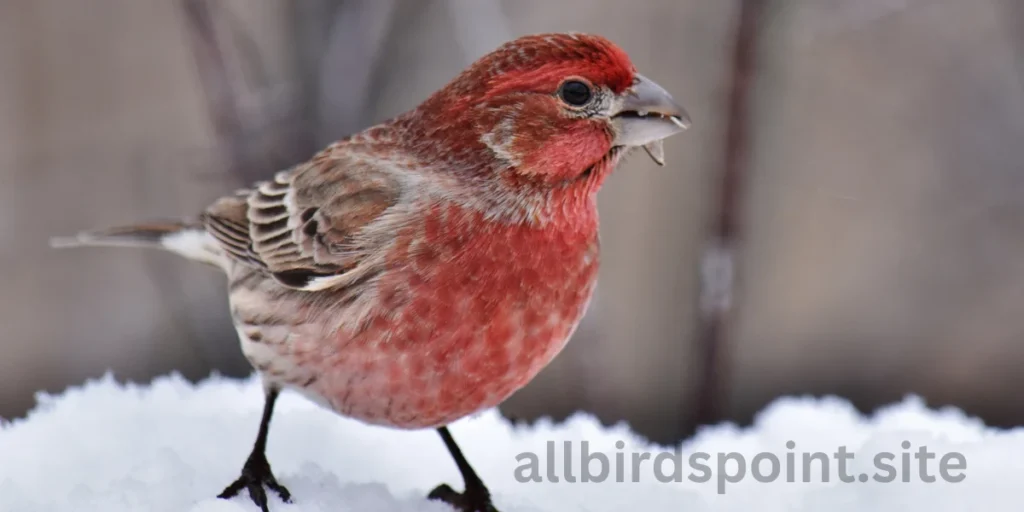
The House Finch is one of the most common small birds with a red head, especially in North America. Male House Finches have bright red plumage on their heads and throats, which contrasts with their brown-streaked bodies. The red color varies in intensity, depending on the diet of the individual bird. Females, on the other hand, are brown and lack the red coloration.
- Size: About 5-6 inches long.
- Habitat: House Finches are adaptable birds and can be found in urban areas, suburban gardens, forests, and open woodlands. They are commonly seen at bird feeders.
- Diet: Their diet primarily consists of seeds, grains, and berries. They are also known to eat insects, especially during the breeding season.
| Feature | Details |
|---|---|
| Color | Bright red head and chest (males), brown streaked body |
| Location | North America, urban areas, backyards |
| Behavior | Social, often seen in flocks, adaptable to human environments |
| Notable | Common visitor to bird feeders, nests in unusual places like hanging planters |
The House Finch is a social bird, often seen in small flocks. Their cheerful song is a common sound in many neighborhoods. They are also known for their nesting habits, often choosing to build nests in unusual places like hanging planters or on window ledges.
2. Common Redpoll
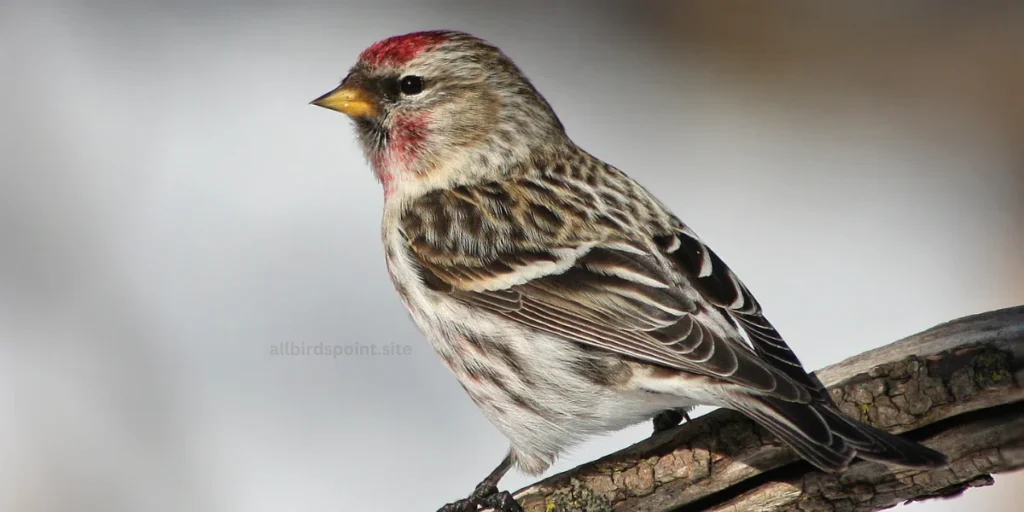
The Common Redpoll is a small, hardy bird that thrives in colder climates. It is easily identified by the bright red patch on its forehead, which stands out against its overall brown and white plumage. The red on their heads becomes more vibrant during the winter months.
- Size: About 5 inches long.
- Habitat: Common Redpolls breed in the Arctic and subarctic regions but migrate southward during the winter. They are often seen in open woodlands, tundra, and areas with shrubs.
- Diet: Their diet mainly includes seeds, particularly from birch and alder trees. They are also known to eat insects and spiders during the breeding season.
| Feature | Details |
|---|---|
| Color | Red patch on forehead, brown and white body |
| Location | Arctic and subarctic regions, open woodlands |
| Behavior | Migrates south in winter, often seen in flocks |
| Notable | Hardy bird, can survive in extreme cold, energetic forager |
Common Redpolls are known for their ability to survive in extremely cold conditions. They often travel in flocks and can be seen foraging on the ground or in trees for food. Their energetic behavior and constant movement make them a joy to watch.
3. Northern Cardinal

The Northern Cardinal is one of the most recognizable birds in North America, thanks to its brilliant red plumage. Males are entirely red with a black mask around their eyes, while females are a pale brown with reddish tinges. The bright red color of the male is particularly striking, making it a favorite among birdwatchers.
- Size: About 8-9 inches long.
- Habitat: Northern Cardinals are found in woodlands, gardens, shrublands, and wetlands. They are common visitors to bird feeders.
- Diet: Their diet consists of seeds, fruits, and insects. They are particularly fond of sunflower seeds.
| Feature | Details |
|---|---|
| Color | Vibrant red head and body (males), brown with reddish tinges (females) |
| Location | North America, woodlands, gardens |
| Behavior | Territorial, often seen singing loudly |
| Notable | Popular in gardens, distinctive song, does not migrate |
Northern Cardinals are territorial birds, and males are known to be very protective of their area. Their loud, clear whistles are a common sound in many neighborhoods, especially during the breeding season. Cardinals do not migrate, so they can be seen year-round.
4. Red-headed Woodpecker
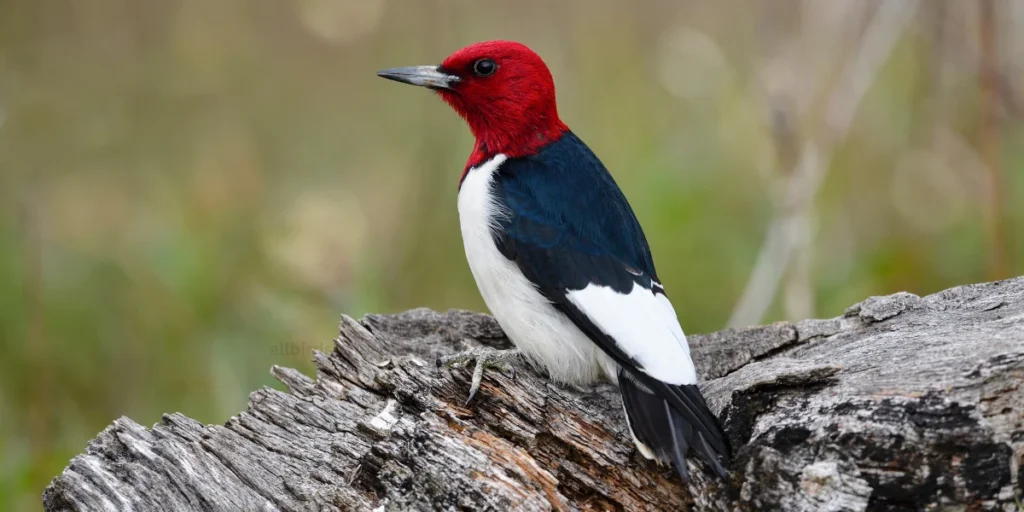
The Red-headed Woodpecker is a striking bird with a completely red head, neck, and throat, contrasting with its white body and black wings. This bold coloration makes it one of the most easily identifiable woodpeckers in North America.
- Size: About 7-9 inches long.
- Habitat: Red-headed Woodpeckers are typically found in open woodlands, groves, orchards, and even savannas. They prefer areas with dead trees, where they can find insects and build their nests.
- Diet: Their diet includes insects, seeds, fruits, and nuts. They are also known to catch insects in flight and store food for later use.
| Feature | Details |
|---|---|
| Color | Entirely red head, neck, and throat, white body with black wings |
| Location | North America, open woodlands, groves |
| Behavior | Territorial, stores food in tree crevices |
| Notable | Known for pecking on trees, distinctive red head and strong flight |
Red-headed Woodpeckers are known for their strong territorial behavior and their habit of storing food in tree crevices. They are excellent fliers and are often seen catching insects mid-air. Their distinctive red head and unique behaviors make them a favorite among bird enthusiasts.
5. Summer Tanager

The Summer Tanager is a beautiful bird known for its all-red plumage, which is particularly vibrant in males. Females are yellow or orange, making the males’ red color even more noticeable. These birds are often heard before they are seen, thanks to their distinctive song.
- Size: About 6-7 inches long.
- Habitat: Summer Tanagers are typically found in open woodlands, especially those with oak and pine trees. They are also seen in parks and gardens.
- Diet: They primarily eat insects, including bees and wasps, which they catch in flight. They also eat fruits and berries.
| Feature | Details |
|---|---|
| Color | All-red body (males), yellow or orange (females) |
| Location | North America, open woodlands, parks |
| Behavior | Migratory, often seen high in trees |
| Notable | Feeds on insects and fruits, melodious song |
Summer Tanagers are migratory birds, spending their winters in Central and South America. During the summer, they are often seen perched high in trees, singing their melodious song. Their bright red color and cheerful song make them a delight to observe.
6. Crimson Sunbird
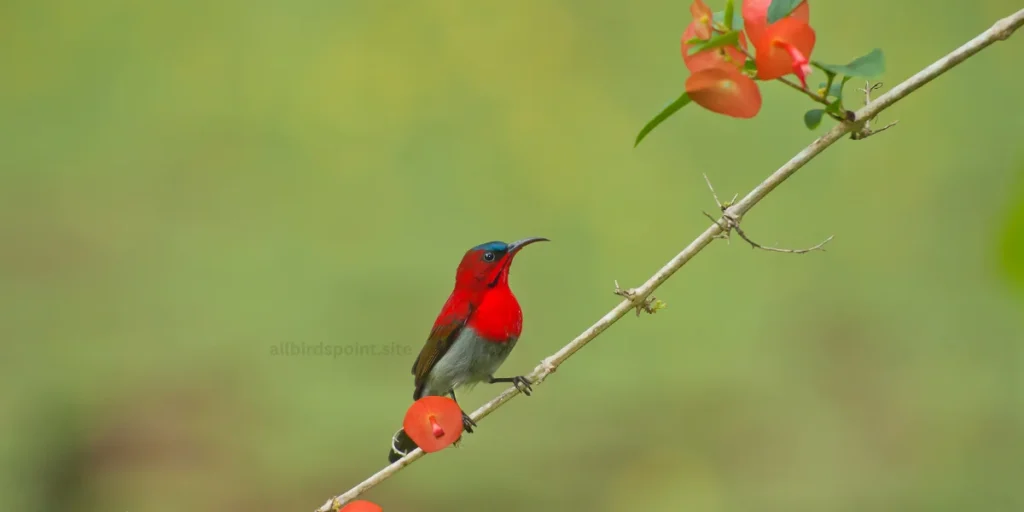
The Crimson Sunbird is a small, vibrant bird found in parts of Asia. Males have a striking red head, throat, and upper breast, which contrast beautifully with their metallic green wings and blue tail. Females are olive-green with a yellowish underside.
- Size: About 4 inches long.
- Habitat: Crimson Sunbirds are typically found in forests, gardens, and shrublands. They are also attracted to flowering plants where they can feed on nectar.
- Diet: Their diet mainly consists of nectar, but they also eat insects and spiders.
| Feature | Details |
|---|---|
| Color | Bright red head, throat, and upper breast, metallic green wings |
| Location | Asia, particularly tropical forests and gardens |
| Behavior | Hovers while feeding on nectar, very agile |
| Notable | Compared to hummingbirds, vibrant coloration, feeds on flowering plants |
Crimson Sunbirds are often compared to hummingbirds because of their small size and their habit of hovering while feeding on nectar. They are active and agile birds, flitting from flower to flower. Their brilliant red coloration makes them one of the most attractive birds in their range.
7. Vermilion Flycatcher
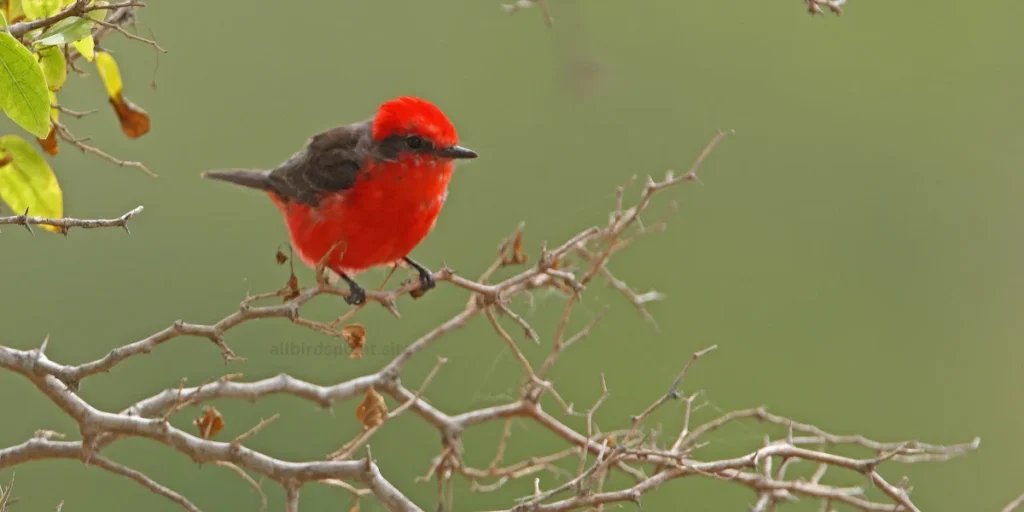
The Vermilion Flycatcher is a small bird with a fiery red head, chest, and belly, making it one of the most colorful flycatchers in the Americas. Females, however, are brownish with a peach-colored belly.
- Size: About 5-6 inches long.
- Habitat: Vermilion Flycatchers are typically found in open areas near water, such as rivers, lakes, and wetlands. They are also seen in deserts and grasslands.
- Diet: Their diet mainly consists of insects, which they catch in mid-air.
| Feature | Details |
|---|---|
| Color | Fiery red head, chest, and belly (males), brownish (females) |
| Location | Americas, especially near water, deserts, and grasslands |
| Behavior | Perches conspicuously while hunting insects |
| Notable | Known for bright color and aerial insect-catching skills |
Vermilion Flycatchers are known for their striking appearance and their habit of perching conspicuously while waiting for insects to fly by. Their bright red color and aerial acrobatics make them a favorite among birdwatchers.
8. Scarlet Robin

The Scarlet Robin is a small bird native to Australia, easily recognized by the bright red chest and forehead of the male. Females are brownish with a paler red wash on the chest. These birds are a common sight in gardens and woodlands.
- Size: About 5 inches long.
- Habitat: Scarlet Robins are typically found in forests, woodlands, and gardens. They prefer areas with plenty of trees and shrubs.
- Diet: Their diet consists mainly of insects and spiders, which they catch on the ground or in the air.
| Feature | Details |
|---|---|
| Color | Bright red chest and forehead (males), brownish (females) |
| Location | Australia, forests, woodlands, gardens |
| Behavior | Often seen perched in visible locations, sings melodious songs |
| Notable | Active and bold, easily recognizable by red chest |
Scarlet Robins are known for their bold behavior, often perching in visible locations and singing their sweet, melodic song. Their bright red chest is a standout feature, making them easy to spot even from a distance.
9. Pine Grosbeak
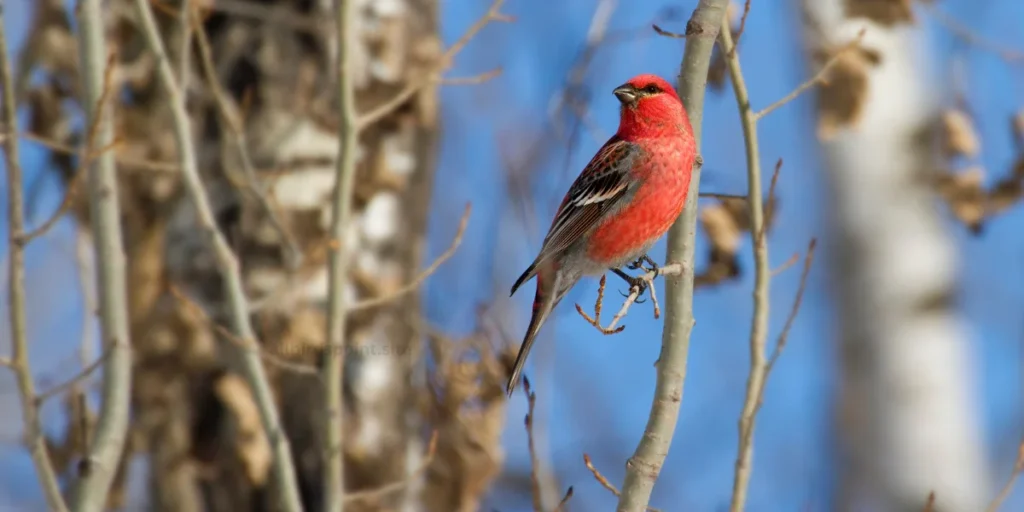
The Pine Grosbeak is a plump, large-billed bird with a reddish head and chest, giving it a striking appearance, especially against the backdrop of snowy landscapes. Females are olive-yellow with grayish wings.
- Size: About 8-10 inches long.
- Habitat: Pine Grosbeaks are typically found in boreal forests, especially those with coniferous trees. They are also seen in mountainous areas.
- Diet: Their diet mainly includes seeds, berries, and buds. They are also known to eat insects during the breeding season.
| Feature | Details |
|---|---|
| Color | Reddish head and chest, olive-yellow (females) |
| Location | Boreal forests, mountainous areas, North America |
| Behavior | Gentle and tame, forages in flocks |
| Notable | Plump appearance, striking in winter, soft calls |
Pine Grosbeaks are gentle and tame birds, often allowing close observation. Their slow, deliberate movements and soft, whistling calls add to their charm. Their reddish plumage is particularly striking in winter when they are often seen foraging in flocks.
10. Cassin’s Finch
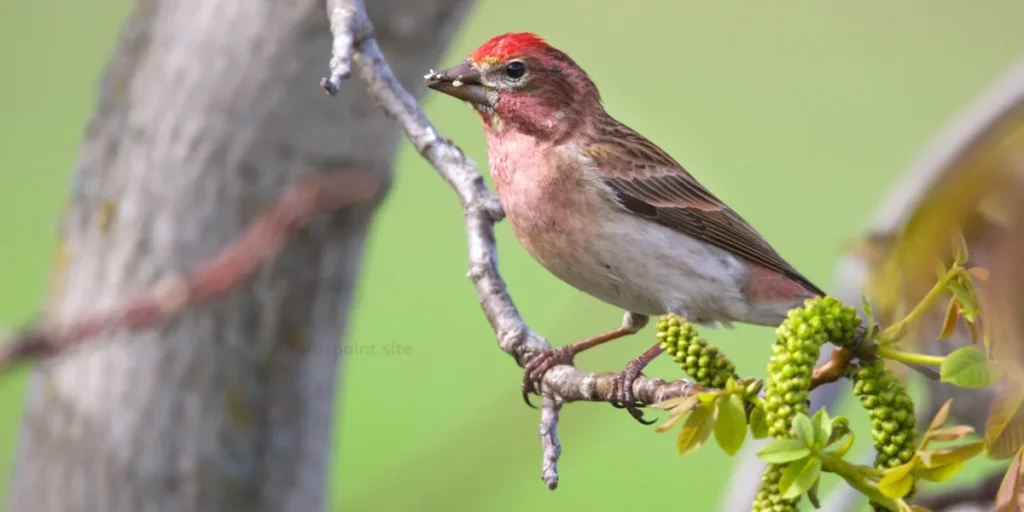
Cassin’s Finch is a small bird with a raspberry-red crown and chest, which contrasts with its streaked brown back and wings. Females are brown with streaked underparts and lack the red coloration.
- Size: About 6 inches long.
- Habitat: Cassin’s Finches are typically found in mountainous areas, coniferous forests, and woodlands. They are also seen in open areas with scattered trees.
- Diet: Their diet primarily consists of seeds, buds, and fruits. They are also known to eat insects during the breeding season.
| Feature | Details |
|---|---|
| Color | Raspberry-red crown and chest, brown streaked body |
| Location | Western United States, coniferous forests and woodlands |
| Behavior | Social, often found in flocks |
| Notable | Cheerful song, striking appearance, migratory habits |
Cassin’s Finches are social birds, often seen in flocks, especially during the winter. Their cheerful song and striking appearance make them a favorite among birdwatchers in the western United States.
Conclusion
Small birds with red heads are a diverse group, each with its own unique characteristics and behaviors. From the common House Finch found in many backyards to the exotic Crimson Sunbird of Asia, these birds add a splash of color to the natural world. Whether you’re a seasoned birdwatcher or just someone who enjoys observing nature, these ten small birds with red heads are sure to capture your attention and admiration. By learning more about these birds, you can appreciate the beauty and diversity of birdlife in different parts of the world.
FAQs
- What are some small birds with red heads?
Small birds with red heads include the House Finch, Common Redpoll, and Northern Cardinal. - Where can I find small birds with red heads?
These birds can be found in various habitats like backyards, forests, and open woodlands across North America and other regions. - Do all male birds have red heads?
Not all male birds have red heads, but in some species like the House Finch and Northern Cardinal, the males do. - What do small red-headed birds eat?
Most of these birds eat seeds, insects, and berries. - Are small birds with red heads migratory?
Some are migratory, like the Common Redpoll, while others, like the Northern Cardinal, are year-round residents. - Why do some birds have red heads?
The red color often helps males attract mates and can indicate health and vitality. - Can I attract small birds with red heads to my garden?
Yes, by providing bird feeders with seeds and planting native shrubs and trees.

1 thought on “10 Best Small Birds with Red Heads: Photos & Guide”